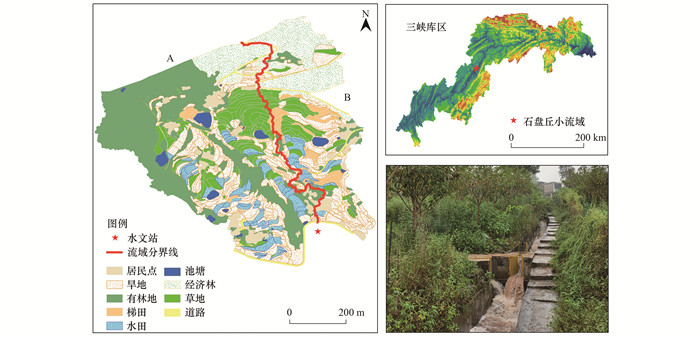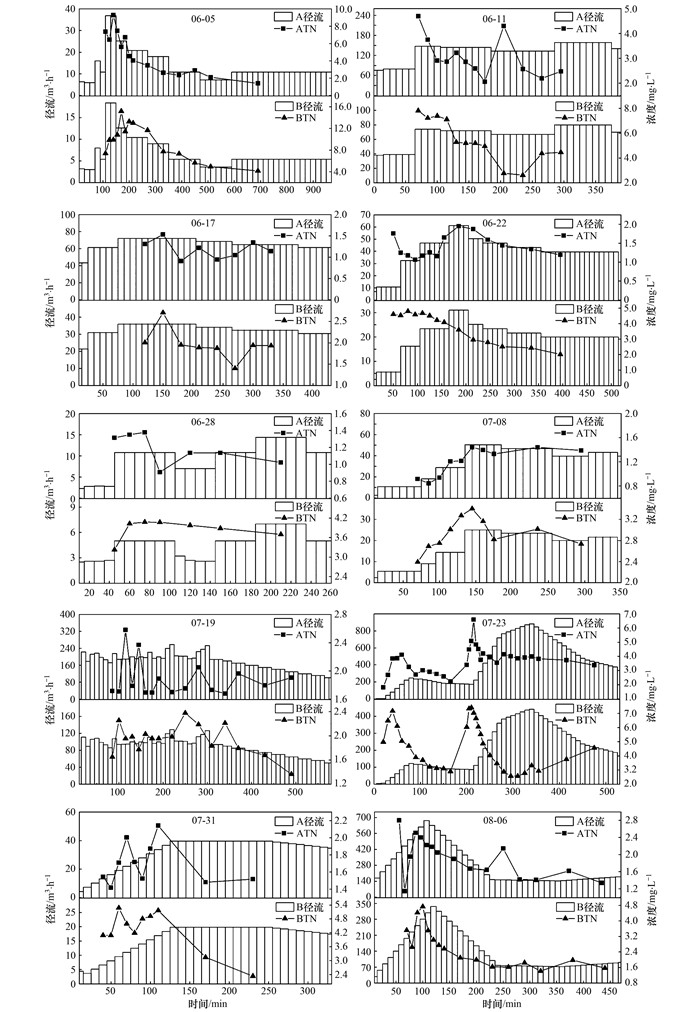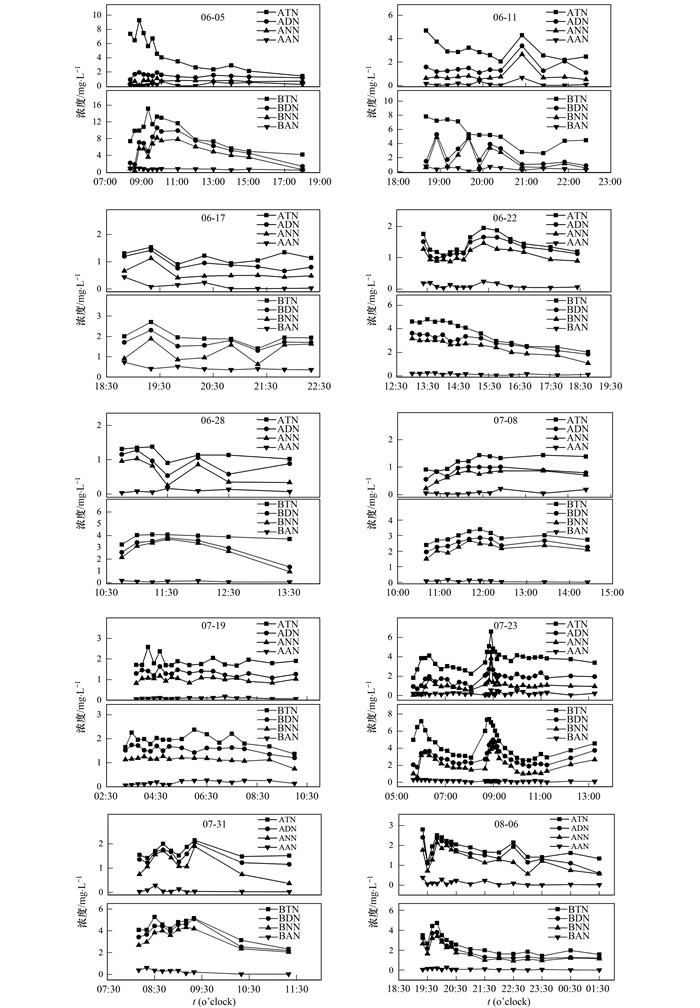2. 中国科学院、水利部成都山地灾害与环境研究所, 成都 610041
2. Institute of Mountain Hazards and Environment, Chinese Academy of Sciences and Ministry of Water Resources, Chengdu 610041, China
三峡库区由于特殊的空间位置、社会经济情况、人口分布以及三峡大坝工程修筑等问题使农业面源污染问题更加突出, 坡耕地水土流失导致的养分流失成为三峡库区面源污染的重要来源[1].三峡库区主干和支流的水质情况都不容乐观, 高水位期间, 部分支流以及湖泊将会迎来干流的倒灌, 会导致氮、磷大幅增加[2].同时每年大量的氮、磷汇入库区, 导致库区的水质严重下降, 已有部分回水区域出现水华现象[3].氮在水土流失导致的面源污染中占据了很大比例[4~6], 其主要通过径流[7]和泥沙[8, 9]两部分携带, 与泥沙中氮素的流失量相比, 部分小流域径流携带氮素所占比例更大[10, 11].
不同土地利用配置将会改变降雨对氮流失的影响, 主要包括以下两方面, 一方面地表覆盖层[12~14]减轻雨水对地表的击溅作用, 从而减少土壤中的氮通过雨水作用汇入径流, 另一方面不同土地利用方式[15, 16]对地表径流和地下水的氮含量产生影响[17].在Florida湖泊发现[18], 高农业占比、林地覆盖和湿地面积的配置会影响湖泊的养分浓度.在王家沟小流域配置三带等高农桑能显著降低地表径流中的TN[19], 在坡底布设稻田比坡腰布设稻田的TN和NN去除率要高[20].吴东等[21]对兰陵溪退耕还林后土地利用结构变化分析发现, 林地面积超过85%的监测区, 氮素养分输出的浓度最低.因此更合理的土地利用配置往往会减少氮素的流失.在石盘丘小流域, 朱波等[22]的研究发现居民点、柑橘果园与坡耕地是农业面源污染的主要来源, 邓华等[23]通过监测不同土地利用的养分浓度, 发现TN的流失通量为水田>柑橘园>旱坡地>菜地>林地, 但未对次降雨过程中不同土地利用配置集水区下, 径流中不同形态氮的变化进行深入研究.因此, 本文以石盘丘小流域不同土地利用配置的A、B子集水区为研究对象, 监测2019年10场次降雨过程中A、B子集水区径流中氮的动态变化, 分析次降雨过程中不同土地利用配置下氮素流失特征及规律, 以期为防控三峡库区小流域农业面源污染提供理论支撑和科学依据.
1 材料与方法 1.1 研究区概况本研究在中国科学院2007年建立的三峡库区水土保持与环境研究站进行, 所选取的石盘丘小流域(30°24′N~30°30′N, 108°08′E~108°12′E)位于重庆市忠县石宝镇新政村.流域内海拔范围为119~780 m, 坡度5°~25°之间, 地势南部低, 北部高, 低山、丘陵、阶地、低洼地和河谷地相间分布, 属于山地丘陵区.多年降水量在1 000~1 300 mm之间, 属亚热带湿润季风气候.雨季为4~10月, 降雨量约占全年总降雨量的70%[4].石盘丘小流域由两个子集水区A和B组成, A集水区是改造配置的农林水复合集水区, 面积为29.62 hm2, 顶部配置果园林和林地, 中部为草地布设有竹篱护沟、旱地伴有生态池塘, 底部为山谷中的梯级水田, 径流经过生态沟渠和生态湿地流出; B集水区为传统农业集水区, 面积为14.43 hm2, 顶部果园林, 中部和低部多为旱地伴有山坪塘, 为传统耕作模式.小流域的土地利用分布见图 1.

|
图 1 研究区土地利用及采样位置示意 Fig. 1 Study area location and sampling sites |
在A和B集水区的出水口处设置巴歇尔水槽, 在巴歇尔水槽内设置自动流量监测器, 实时记录流量变化.遇降雨在A和B集水区的巴歇尔水槽出口处采集径流样, 每10 min或30 min采集一次, 径流量较大时加密采集, 直到降雨结束后, 再采集2~3次.水样收集在500 mL塑料瓶中, 及时带回储存于4℃冰箱中, 并在48 h内进行养分的测定.径流样的采集点如图 1所示.其中总氮(TN)采用原样直接处理测定, 可溶性总氮(DN)、硝态氮(NN)和铵态氮(AN)采用通过0.45 μm滤膜的水样进行测定.实验室测定方法: TN和DN采用碱式过硫酸钾消解-紫外分光光度法、NN采用紫外分光光度法和AN采用靛酚蓝比色法.
1.3 数据处理采用EMC来评估次降雨过程中径流的污染负荷, EMC(mg·L-1)是指次降雨径流污染物的加权事件平均浓度, 其公式表示为:

|
(1) |
式中, M是次降雨持续时间内污染物的总质量(g), V是次降雨径流总量(m3), ct是间隔时间内的污染物浓度(mg·L-1), Qt是时间间隔内的次降雨径流量(m3·min-1), Δt指时间间隔(min).本研究采用Excel 2010进行相关数据的统计和计算, 用SPSS 25.0进行单因素方差分析和皮尔逊相关分析, 用邓肯多重比较法分析处理间的差异, 用Origin 2018制图.
2 结果与分析 2.1 次降雨过程中总氮与径流量变化特征由图 2可知, A集水区的TN浓度范围为:0.84~9.28mg·L-1, 最大流失浓度出现在6月5日的次降雨过程中, 最小流失浓度出现在7月8日的次降雨过程中.场均径流量最大值为7月23日次降雨的425.77 m3·h-1.B集水区的TN浓度范围为:1.37~15.17mg·L-1, 最大和最小流失浓度分别出现在6月5日和7月19日的次降雨过程中.最大的场均径流量212.98 m3·h-1也出现在7月23日的次降雨.根据《地表水环境质量标准》(GB 3838-2002), 总氮浓度作为水质评价指标, 石盘丘小流域属于地表水质量的劣Ⅴ类, 这与之前陈仕奇等[4]在石盘丘小流域的监测结果一致, 与重庆市中国农业科学院柑橘研究所[24]、王家沟小流域[20]、彭溪河回水区[5]和兰陵溪流域[6]的结果也基本一致, 三峡库区各小流域都面临氮流失的风险.

|
图 2 次降雨过程中径流量和TN变化过程 Fig. 2 Variation in the runoff flow rate and TN during rainfall events |
在10场次降雨过程中, 仅有7月23日出现了较为明显的两次径流和TN峰值, A集水区的两次TN峰值分别为4.11 mg·L-1和6.60mg·L-1, 第一次TN峰值约为第二次峰值的62%; B集水区的TN峰值分别为7.16mg·L-1和7.40mg·L-1, 而第一次峰值占到了第二次峰值的97%.在7月19日的次降雨过程中, A、B集水区的径流量和TN浓度都出现了剧烈的波动, 存在多个径流量和TN浓度峰值.其他场次降雨过程中, 基本只出现一个流量峰值和一个TN峰值.所有次降雨过程中, A集水区和B集水区的流量基本同时达到峰值, 但是总氮的峰值出现的时间存在差异.集水区A有6场次降雨的总氮峰值出现在流量峰值之后, 4场次降雨的总氮峰值出现在流量峰值之前, B集水区有5场次降雨的总氮峰值出现在流量峰值之前, 5场次降雨的总氮峰值出现在流量峰值之后.其中6月22日, 集水区A的总氮峰值比流量峰值晚20 min, 而集水区B的总氮峰值比流量峰值早85 min.
2.2 次降雨过程中径流不同形态氮流失特征根据10场次降雨的EMC统计, A集水区的TN、DN、NN和AN的平均EMC分别为2.09、1.32、0.86和0.12mg·L-1, B集水区的TN、DN、NN和AN的平均EMC分别为3.67、2.63、2.11和0.23mg·L-1.集水区A的DN/TN比值为37%~91%, 场均为69%; B集水区的DN/TN比例为43%~89%, 场均为75%.A和B集水区的可溶性氮中, 硝态氮均为主要成分, 分别平均占67%和80%, 而AN在A和B集水区为10%和9%(见表 1).
|
|
表 1 不同形态氮的EMC Table 1 EMC of different nitrogen forms |
在研究过程中, DN和NN的变化趋势与TN基本一致.但是, DN的趋势更接近TN, 而NN的趋势更接近DN.在10场次降雨过程中, AN所占比例最小, AN在低浓度范围内波动, 没有明显地受到某一形态氮的影响.在6月5日、6月17日、6月28日、7月8日、7月23日、7月31日和8月6日的次降雨过程中, TN、DN和NN先上升至峰值, 然后逐渐减少; 6月11日、6月22日和8月6日的次降雨过程中, TN、DN和NN先降低, 再升至峰值, 然后逐渐减少, 具体趋势见图 3.

|
图 3 氮素的变化过程 Fig. 3 Process change of nitrogen nutrient |
不同土地利用配置对小流域氮流失有着极为重要的作用, A集水区的配置体系中, 顶部的林地和中部的草地会有覆盖和过滤的作用[25, 26], 覆盖可以富养土壤中的有效氮[27]; 而底部的梯级水田[28]和生态沟渠起着吸附过滤的作用[29~31], 中部的生态池塘和底部的生态湿地[32]又起着沉降作用, 配置的各措施形成的水土保持体系在实际的运行中减少了养分流失量, 所以A集水区的TN浓度小于B集水区.
由表 2可知, 不同的次降雨中没有一致的滞后效应[33], 除了6月22日的次降雨过程中, A和B集水区的流量峰值和TN峰值出现的时间上存在不同, 其余场次降雨过程中A和B集水区的峰值出现顺序保持了一致性.鉴于7月19日的次降雨过程由于雨强频繁变化导致地表产流和TN浓度不规律, 未对其峰值等特征值进行统计分析; 7月23日的径流过程中出现了两次TN峰和流量峰, 因此统计为07-23-1和07-23-2.在7月23日的降雨中, A集水区与B集水区在TN第二次峰值相差10%左右的情况下, A集水区比B集水区的第一次峰值减少43%.第一次降雨时, 由于B集水区(传统农业集水区)保持了传统的耕作模式, 雨水对地表的溅蚀和冲刷会带走大量的氮素, 导致了氮素会快速上升, 但在A集水区(农林水复合集水区)配置的水土保持体系延缓了峰值的出现和减少了养分流失量.因此相对于B集水区两次TN峰值基本一致, A集水区对TN的首次峰值的消减能力要大于第二次TN峰值, 在实践中也要考虑降雨第二次径流峰导致养分流失的风险.
|
|
表 2 次降雨径流峰值和总氮峰值特征1) Table 2 Characteristics of runoff and TN peaks for ten rainfall events |
降雨对径流的直接影响[34], 从而影响径流对氮素的携带. 7月31和8月6日的TN峰值均出现在流量峰值之前, 经调查径流过程发现, 这两场次降雨之前均出现了断流情况.在十里铺小流域的研究中发现径流污染物与降雨前的非降雨天数呈正相关[35], 所以没有前期降雨和径流将影响污染物峰值和流量峰值的出现时间.同为大流量的8月6日和7月23日第二次降雨中, 8月6日次降雨A和B集水区的TN峰值都只提前20 min, 而7月23日分别提前120 min和125 min, 通过实地考察及查阅相关资料发现8月6日降雨前, 径流存在断流现象, 径流量从0到大于300 m3·h-1仅仅只花了50 min; 在7月23日之前均有径流产生, 且从2.8 m3·h-1到大于300 m3·h-1花了210 min, 因此笔者推断在暴雨情况下, 断流和流量暴增均可能会影响农林水复合集水区对污染物质的控制能力.
3.2 不同土地利用配置对不同形态氮的影响本研究监测到的所有次降雨中, A集水区各形态氮的EMC都要比B集水区小, B集水区的DN/TN和NN/DN都比A集水区大, 且NN/DN有显著差异(P < 0.05), 但两个集水区的DN/TN无显著差异(表 3).樊才睿等[36]在呼伦贝尔草原发现NN为主要流失形态, 李吉平等[37]在洪泽湖地区林地的研究发现NN也为主要流失形态, 且NN和AN比农田的要少得多.B集水区为传统农业集水区, 缺少有效的养分控制措施, 径流对地表的直接作用又导致NN的增加[38], 而高浓度的可溶性营养物如NN容易被水携带[39], A集水区通过系列水土保持措施减少了直接的地表径流, 硝氮被径流携带也就受到限制.在耕地中, 玉米的种植占比与NN浓度成正相关[40], 而水稻呈反相关[15], A集水区的水稻种植面积大于B集水区, 而B集水区的玉米种植占比大于A集水区.由于这些因素, B集水区的NN/DN大于A集水区, 表明在集水区A的土地利用配置有效减少通过沟渠进入河流的氮素占比.
|
|
表 3 次降雨的平均EMC1) Table 3 Average EMC of all rainfall events |
比较10场次降雨产流的氮浓度, A集水区的平均TN、DN、NN和AN浓度分别为(2.09±1.02)、(1.31±0.35)、(0.86±0.24)和(0.12±0.05)mg·L-1, B集水区的平均TN、DN、NN和AN浓度分别为(3.66±1.88)、(2.63±1.15)、(2.10±0.88)和(0.23±0.21)mg·L-1.除AN外, 两个集水区的氮素浓度均存在显著差异(P < 0.05, 表 3).原始耕作方式造成的养分流失是三峡库区面源污染的重要来源[41], 而A集水区的多层次水土保持措施对氮素拦截消纳能有效地减少自然耕作造成的氮素流失.
4 结论在石盘丘小流域, 断流和流量暴增均可能会影响小面积的农林复合流域对污染物质的控制能力, 配置合理的水土保持措施体系, 能更好地应对不同情况下的氮流失.在该研究区, 氮的流失主要以溶解态氮为主, NN为溶解态氮中主要养分形式.与传统农业集水区相比, 农林水复合系统能有效地减少氮素的流失, 明显消减第一次TN峰值.本研究期间土地利用配置变化显著(P < 0.05)减少了石盘丘小流域TN、DN、NN和NN/DN.农林水复合集水区在面源污染的氮素治理方面发挥了更积极作用, 因此, 更合理地土地利用配置是减少面源污染的方向之一.
| [1] | Fan F L, Xie D T, Wei C F, et al. Reducing soil erosion and nutrient loss on sloping land under crop-mulberry management system[J]. Environmental Science and Pollution Research, 2015, 22(18): 14067-14077. DOI:10.1007/s11356-015-4608-2 |
| [2] | Huang Y L, Zhang P, Liu D F, et al. Nutrient spatial pattern of the upstream, mainstream and tributaries of the Three Gorges Reservoir in China[J]. Environmental Monitoring and Assessment, 2014, 186(10): 6833-6847. DOI:10.1007/s10661-014-3892-5 |
| [3] |
郑丙辉, 曹承进, 秦延文, 等. 三峡水库主要入库河流氮营养盐特征及其来源分析[J]. 环境科学, 2008, 29(1): 1-6. Zheng B H, Cao C J, Qin Y W, et al. Analysis of nitrogen distribution characters and their sources of the major input rivers of Three Gorges Reservoir[J]. Environmental Science, 2008, 29(1): 1-6. |
| [4] |
陈仕奇, 龙翼, 严冬春, 等. 三峡库区石盘丘小流域氮磷输出形态及流失通量[J]. 环境科学, 2020, 41(3): 1276-1285. Chen S Q, Long Y, Yan D C, et al. Characteristics of nitrogen and phosphorus output and loss flux in the Shipanqiu watershed, Three Gorges Reservoir Area[J]. Environmental Science, 2020, 41(3): 1276-1285. |
| [5] |
张磊, 蔚建军, 付莉, 等. 三峡库区回水区营养盐和叶绿素a的时空变化及其相互关系[J]. 环境科学, 2015, 36(6): 2061-2069. Zhang L, Wei J J, Fu L, et al. Temporal and spatial variation of nutrients and chlorophyll a, and their relationship in Pengxi River backwater area, Three Gorges Reservoir[J]. Environmental Science, 2015, 36(6): 2061-2069. |
| [6] |
张林, 黄志霖, 肖文发, 等. 三峡库区兰陵溪小流域径流氮磷输出及其降雨径流过程特征[J]. 环境科学, 2018, 39(2): 792-799. Zhang L, Huang Z L, Xiao W F, et al. Characteristics of nitrogen and phosphorus output in runoff and rainfall runoff in Lanlingxi watershed, Three Gorges Reservoir Area[J]. Environmental Science, 2018, 39(2): 792-799. |
| [7] | Yang Y Y, Toor G S. δ15N and δ18O Reveal the sources of nitrate-nitrogen in urban residential stormwater runoff[J]. Environmental Science and Technology, 2016, 50(6): 2881-2889. DOI:10.1021/acs.est.5b05353 |
| [8] | Wang C Y, Lv Y C, Li Y W. Riverine input of organic carbon and nitrogen in water-sediment system from the Yellow River estuary reach to the coastal zone of Bohai Sea, China[J]. Continental Shelf Research, 2018, 157: 1-9. DOI:10.1016/j.csr.2018.02.004 |
| [9] |
吴亚林, 李帅东, 江俊武, 等. 百年来滇池沉积物中不同形态氮分布及埋藏特征[J]. 环境科学, 2017, 38(2): 517-525. Wu Y L, Li S D, Jiang J W, et al. Distribution and burial characteristics of nitrogen forms in sediment of Dianchi lake during last century[J]. Environmental Science, 2017, 38(2): 517-525. |
| [10] | Zhu Q D, Sun J H, Hua G F, et al. Runoff characteristics and non-point source pollution analysis in the Taihu Lake Basin: a case study of the town of Xueyan, China[J]. Environmental Science and Pollution Research, 2015, 22(19): 15029-15036. |
| [11] | Li S M, Wang X L, Qiao B, et al. First flush characteristics of rainfall runoff from a paddy field in the Taihu Lake watershed, China[J]. Environmental Science and Pollution Research, 2017, 24(9): 8336-8351. |
| [12] | Ghahramani A, Ishikawa Y, Gomi T, et al. Effect of ground cover on splash and sheetwash erosion over a steep forested hillslope: A plot-scale study[J]. CATENA, 2011, 85(1): 34-47. |
| [13] | Oliveira L M, Maillard P, de Andrade Pinto é J. Modeling the effect of land use/land cover on nitrogen, phosphorous and dissolved oxygen loads in the Velhas River using the concept of exclusive contribution area[J]. Environmental Monitoring and Assessment, 2016, 188(6). DOI:10.1007/s10661-016-5323-2 |
| [14] | Yao J J, Cheng J H, Zhou Z D, et al. Effects of herbaceous vegetation coverage and rainfall intensity on splash characteristics in northern China[J]. CATENA, 2018, 167: 411-421. |
| [15] | Chen C L, Gao M, Xie D T, et al. Spatial and temporal variations in non-point source losses of nitrogen and phosphorus in a small agricultural catchment in the Three Gorges Region[J]. Environmental Monitoring and Assessment, 2016, 188(4). DOI:10.1007/s10661-016-5260-0 |
| [16] | Wu L, Long T Y, Li C M. The simulation research of dissolved nitrogen and phosphorus non-point source pollution in Xiao-Jiang watershed of Three Gorges Reservoir area[J]. Water Science and Technology, 2010, 61(6): 1601-1616. |
| [17] | Wu L, Long T Y, Cooper W J. Simulation of spatial and temporal distribution on dissolved non-point source nitrogen and phosphorus load in Jialing River Watershed, China[J]. Environmental Earth Sciences, 2012, 65(6): 1795-1806. DOI:10.1007/s12665-011-1159-9 |
| [18] | Xiong C, Hoyer M V. Influence of land use and rainfall variability on nutrient concentrations in Florida Lakes[J]. Lake and Reservoir Management, 2019, 35(1): 25-37. |
| [19] |
张洋, 樊芳玲, 周川, 等. 三峡库区农桑配置对地表氮磷流失的影响[J]. 土壤学报, 2016, 53(1): 189-201. Zhang Y, Fan F N, Zhou C, et al. Effects of crop/mulberry intercropping on surface nitrogen and phosphorus losses in Three Gorges Reservoir Area[J]. Acta Pedologica Sinica, 2016, 53(1): 189-201. |
| [20] |
陈成龙, 高明, 倪九派, 等. 三峡库区小流域稻田空间格局对氮磷流失影响[J]. 环境科学, 2017, 38(5): 1889-1897. Chen C L, Gao M, Ni J P, et al. Influence of spatial pattern of paddy field on the losses of nitrogen and phosphorus in Three Gorges Reservoir Area[J]. Environmental Science, 2017, 38(5): 1889-1897. |
| [21] |
吴东, 黄志霖, 肖文发, 等. 三峡库区小流域土地利用结构变化及其氮素输出控制效应: 以兰陵溪小流域为例[J]. 环境科学, 2016, 37(8): 2940-2946. Wu D, Huang Z L, Xiao W F, et al. Land use structure change and its control effect of nitrogen output in a small watershed of Three Gorges Reservoir Area: a case study of Lanlingxi Watershed[J]. Environmental Science, 2016, 37(8): 2940-2946. |
| [22] |
朱波, 汪涛, 王建超, 等. 三峡库区典型小流域非点源氮磷污染的来源与负荷[J]. 中国水土保持, 2010(10): 34-36. Zhu B, Wang T, Wang J C, et al. Source and load of non-point source nitrous and phosphorus pollution of typical small watersheds in the Three Gorges Reservoir Area[J]. Soil and Water Conservation in China, 2010(10): 34-36. |
| [23] |
邓华, 高明, 龙翼, 等. 石盘丘小流域不同土地利用方式下土壤氮磷流失形态及通量[J]. 环境科学, 2021, 42(1): 251-262. Deng H, Gao M, Long Y, et al. Characteristics of soil nitrogen and phosphorus losses under different land-use types in Shipanqiu Watershed[J]. Environmental Science, 2021, 42(1): 251-262. |
| [24] | Zhang Y, Xie D T, Ni J P, et al. Conservation tillage practices reduce nitrogen losses in the sloping upland of the Three Gorges Reservoir area: No-till is better than mulch-till[J]. Agriculture, Ecosystems & Environment, 2020, 300. DOI:10.1016/j.agee.2020.107003 |
| [25] | Mello K, Valente R A, Randhir T O, et al. Effects of land use and land cover on water quality of low-order streams in Southeastern Brazil: Watershed versus riparian zone[J]. CATENA, 2018, 167: 130-138. |
| [26] | Butler D M, Ranells N N, Franklin D H, et al. Ground cover impacts on nitrogen export from Manured Riparian Pasture[J]. Journal of Environmental Quality, 2007, 36(1): 155-162. |
| [27] | Xu Q X, Wang T W, Cai C F, et al. Effects of soil conservation on soil properties of citrus orchards in the Three-Gorges Area, China[J]. Land Degradation & Development, 2012, 23(1): 34-42. |
| [28] | Zhu B, Wang Z H, Wang T, et al. Non-point-source nitrogen and phosphorus loadings from a small watershed in the Three Gorges Reservoir area[J]. Journal of Mountain Science, 2012, 9(1): 10-15. |
| [29] | Li S M, Wang X L, Tu J M, et al. Nitrogen removal in an ecological ditch based on an orthogonal test[J]. Water, Air, & Soil Pollution, 2016, 227(11). DOI:10.1007/s11270-016-3085-7 |
| [30] | Gao Y, Zhu B, Yu G R, et al. Coupled effects of biogeochemical and hydrological processes on C, N, and P export during extreme rainfall events in a purple soil watershed in southwestern China[J]. Journal of Hydrology, 2014, 511: 692-702. |
| [31] | Wang X L, Li J S, Li S M, et al. A study on removing nitrogen from paddy field rainfall runoff by an ecological ditch-zeolite barrier system[J]. Environmental Science and Pollution Research, 2017, 24(35): 27090-27103. |
| [32] | Quin A, Jaramillo F, Destouni G. Dissecting the ecosystem service of large-scale pollutant retention: the role of wetlands and other landscape features[J]. AMBIO, 2015, 44(S1): 127-137. DOI:10.1007/s13280-014-0594-8/fulltext.html |
| [33] | Du X Z, Li X Y, Hao S N, et al. Contrasting patterns of nutrient dynamics during different storm events in a semi-arid catchment of northern China[J]. Water Science and Technology, 2014, 69(12): 2533-2540. |
| [34] | Fang N F, Shi Z H, Li L, et al. The effects of rainfall regimes and land use changes on runoff and soil loss in a small mountainous watershed[J]. CATENA, 2012, 99: 1-8. |
| [35] | Li L Q, Yin C Q, He Q C, et al. First flush of storm runoff pollution from an urban catchment in China[J]. Journal of Environmental Sciences, 2007, 19(3): 295-299. |
| [36] |
樊才睿, 张成福, 史小红, 等. 不同放牧制度草地径流中氮流失及模拟研究[J]. 生态环境学报, 2020, 29(5): 951-960. Fan C R, Zhang C F, Shi X H, et al. Nitrogen loss in surface runoff from Hulun Buir steppe in different grazing systems[J]. Ecology and Environment Sciences, 2020, 29(5): 951-960. |
| [37] |
李吉平, 徐勇峰, 陈子鹏, 等. 洪泽湖地区麦稻两熟农田及杨树林地降雨径流对地下水水质的影响[J]. 中国生态农业学报(中英文), 2019, 27(7): 1097-1104. Li J P, Xu Y F, Chen Z P, et al. Effects of rainfall and runoff on the groundwater quality in farmland and poplar forestland in the area of Hung-tse lake[J]. Chinese Journal of Eco-Agriculture, 2019, 27(7): 1097-1104. |
| [38] | Petersen R J, Prinds C, Jessen S, et al. Riparian lowlands in clay till landscapes part Ⅱ: nitrogen reduction and release along variable flow paths[J]. Water Resources Research, 2020, 56(4). DOI:10.1029/2019WR025810 |
| [39] | Wei L H, Cheng X Q, Cai Y F. Nutrient export via overland flow from a cultivated field of an Ultisol in southern China[J]. Hydrological Processes, 2013, 27(3): 421-432. |
| [40] | McIsaac G F, David M B, Gertner G Z. Illinois River nitrate-nitrogen concentrations and loads: long-term variation and association with watershed nitrogen inputs[J]. Journal of Environmental Quality, 2016, 45(4): 1268-1275. |
| [41] | Luo C Y, Gao Y, Zhu B, et al. Sprinkler-based rainfall simulation experiments to assess nitrogen and phosphorus losses from a hillslope cropland of purple soil in China[J]. Sustainability of Water Quality and Ecology, 2013, 1-2: 40-47. |
 2021, Vol. 42
2021, Vol. 42


